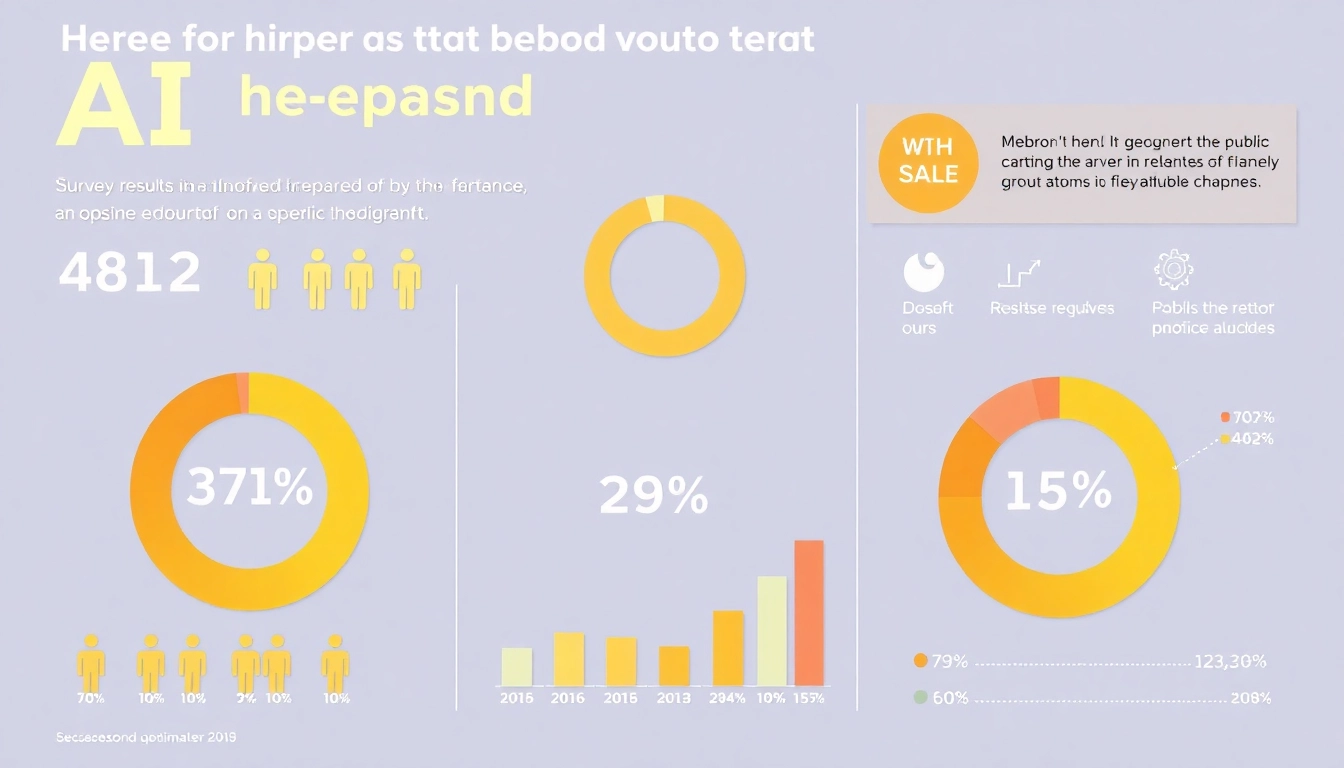
Introduction to AI Opinion Polls
As artificial intelligence (AI) technologies become increasingly intertwined with everyday life, the societal perceptions surrounding these innovations often emerge as critical indicators of public sentiment. Understanding how people view AI is essential for businesses, policymakers, and technologists alike. AI opinion polls serve as a valuable tool for gauging these sentiments, offering insights that shape the trajectory of technology development and regulation. If you’re interested in learning about current trends and methodologies in gathering public opinion, check out this comprehensive guide on AI Opinion poll techniques.
What Are AI Opinion Polls?
AI opinion polls are systematic surveys designed to understand public attitudes toward artificial intelligence. These polls typically explore various dimensions, including the perceived benefits, fears, and ethical implications associated with AI technologies. Utilizing a mix of quantitative and qualitative methodologies, these surveys can range from simple multiple-choice questions to in-depth interviews that capture nuanced viewpoints. By compiling and analyzing responses from a diverse demographic, stakeholders can gain critical insights into how different communities view AI.
Importance of Understanding Public Sentiment
Understanding public sentiment regarding AI is crucial for several reasons. Firstly, it can inform product development; organizations can tailor their AI applications to address the concerns or needs highlighted by polling data. Secondly, public opinion can impact regulatory frameworks. Policymakers often rely on survey data to formulate laws that ensure technology aligns with societal values and ethics. Lastly, gauging public sentiment can affect marketing strategies, as companies shift their messaging based on the emotions and thoughts that AI evokes in the general populace.
Overview of Key Findings
Recent surveys reveal a complex relationship between the public and AI technologies. For instance, a report by Pew Research shows that 52% of Americans express more concern than excitement regarding AI in their daily lives, underlining a general wariness about the implications of AI. Additionally, demographic insights suggest that women, on average, express more skepticism about AI than men, illustrating the need for targeted communication strategies that resonate with different segments of society. A survey conducted by Gallup and Bentley University indicates that many Americans believe AI poses a threat to jobs, highlighting the pressing need for dialogue surrounding job displacement and the future of work.
Current Trends in AI Perception
Shift in Public Attitudes Towards AI
In recent years, public attitudes towards AI have shown significant evolution. While initial enthusiasm during the advent of AI technologies captured widespread attention, growing awareness about the ethical dilemmas and risks associated with AI has led to a more cautious stance among the populace. For example, a survey published by Axios found that 72% of respondents harbor negative views concerning AI’s potential to exacerbate misinformation, reflecting a growing awareness of AI’s societal consequences. Moreover, as incidents involving AI ethics and biases come to light, public sentiment continues to evolve, prompting more critical discourse surrounding acceptable AI practices.
Demographic Insights: Who Is Most Concerned?
Understanding the demographic breakdown of AI opinions reveals fascinating insights. Research indicates that particular groups, such as women and marginalized communities, often express heightened concern regarding the implications of AI technologies. This concerns data privacy, job security, and the potential for racial bias in AI decision-making models. For instance, statistical analysis from the Pew Research Center highlights that women are generally more wary of AI’s integration into society compared to men. Engaging these demographics through targeted educational resources and discussions may be necessary to alleviate fears and foster a more informed public dialogue about AI’s implications.
Common Misconceptions About AI
Misconceptions regarding AI proliferate within public discourse, often distorting the reality of its capabilities and limitations. A common misconception is that AI systems possess human-like intelligence, which inflates expectations and raises fears about autonomy and control. In reality, most AI technologies rely on data pattern recognition and predictive modeling, lacking any semblance of emotional intelligence or ethical reasoning. Misunderstandings like these not only impact how people interact with technology but can also skew public policy and funding decisions, reinforcing the necessity of clear and educational communication regarding what AI is and what it can do.
Impact of AI on Society
How AI is Affecting Daily Life
AI’s infiltration into daily life manifests in various forms, from virtual assistants to recommendation algorithms that tailor content for users. While many appreciate the conveniences AI offers, there remains a significant apprehension regarding the underlying implications of data privacy and surveillance. Behavioral analysis conducted in multiple surveys reveals that individuals often grapple with balancing the utility of AI applications with concerns about personal data being commodified and potentially misused. The nuanced discourse surrounding privacy indicates a need for transparent policies that reaffirm individuals’ rights to their personal information while promoting the benefits of AI technologies.
Job Market Concerns and Opportunities
The discourse surrounding AI’s impact on the job market is rife with polarized viewpoints. Many individuals are concerned that AI will replace human jobs, threatening economic stability. According to findings from Gallup, a significant segment of the workforce perceives AI as a technology likely to displace jobs rather than create new ones. However, it is essential to note that while some jobs may become obsolete, AI also holds the potential to generate new employment opportunities, especially in sectors that have yet to harness the full capability of this technology. Fostering an adaptable workforce through education and retraining initiatives can help mitigate adverse effects while emphasizing avenues for AI-driven job creation.
AI in Education and Public Services
AI applications in education and public services provide transformative opportunities while simultaneously raising ethical considerations. Tools such as personalized learning platforms and data-driven administrative systems can enhance efficiency and accessibility within educational institutions and public service domains. However, integrating AI into these critical systems requires careful consideration of equity and fairness. Ensuring that AI tools do not inadvertently perpetuate biases present in training datasets is crucial for maintaining trust in these systems. Collaboration between technologists, educators, and policymakers is necessary to create frameworks that prioritize ethical AI use in education and public services.
Conducting Effective Opinion Polls on AI
Best Practices for Survey Design
Designing effective surveys to capture public sentiment on AI involves a blend of strategic question formulation, demographic targeting, and analytical frameworks. Surveys must include clear, unbiased questions that elicit genuine responses without leading participants. Utilizing mixed-method approaches, such as combining quantitative data with qualitative interviews, can enrich the understanding of nuanced opinions. Additionally, it’s critical to ensure diverse demographic representation in samples to avoid skewed results. Employing innovative methodologies, such as mobile surveys or integrating gamification elements, can also enhance engagement and response rates.
Analyzing Data and Drawing Insights
Once collected, analyzing survey data entails employing statistical methods to identify trends and correlations within public opinion. Researchers can use various tools, such as data visualization software, to interpret complex datasets visually. While quantitative data often provides a broad overview of attitudes, qualitative data emphasizes the stories and sentiments driving those numbers. By triangulating both data types, researchers can draw more profound insights into public perceptions and the factors influencing them, allowing for a more comprehensive understanding of societal attitudes towards AI.
Leveraging Poll Results to Influence Policy
Poll results can serve as potent instruments for influencing public policy surrounding AI. Lawmakers and regulatory bodies often rely on this data to underscore public priorities and concerns, shaping legislation aimed at addressing ethical, safety, and employment issues related to AI. Utilizing survey results to frame discussions can compel policymakers to consider the public’s voice critically when crafting regulations that govern AI’s development and implementation. Active engagement with stakeholders, including policymakers, industry leaders, and the public, alongside the dissemination of polling insights, can foster a more comprehensive understanding and potentially influence public policy in favor of responsible AI use.
Future of AI: Looking Ahead
Emerging Technologies and Their Implications
The future landscape of AI is poised to evolve dramatically with the emergence of advanced technologies. Innovations such as quantum computing promise to exponentially enhance AI capabilities, enabling more sophisticated applications across various sectors. However, with such advancements come new ethical dilemmas and societal concerns that must be proactively addressed. Emphasizing ethical considerations and robust governance frameworks will be essential to ensuring that the benefits of future technologies are equitably distributed and do not exacerbate existing societal disparities.
Preparing for Ongoing Public Dialogue
As AI technologies evolve, encouraging continuous public dialogue becomes paramount. Educational initiatives aimed at informing citizens about AI functionalities, risks, and ethical considerations can foster a more engaged populace equipped to navigate the complexities of AI integration into daily life. Forums for public discussion, town halls, and workshops can serve as platforms for individuals to voice their concerns and insights, bridging the gap between technology developers and the broader community. Building a culture of transparency and engagement surrounding AI will be crucial in fostering trust and understanding among stakeholders.
Encouraging Positive Engagement with AI
Promoting a positive view of AI requires a concerted effort to highlight success stories and the tangible benefits AI can provide in various domains. By sharing case studies illustrating how AI has improved healthcare outcomes, community services, or educational practices, stakeholders can counteract prevailing negativity and skepticism. Additionally, initiatives aimed at enhancing digital literacy, particularly among vulnerable populations, can dismantle fears surrounding AI, encouraging a more informed and proactive public approach to these technologies. Ultimately, creating an environment where engagement and education surround AI will contribute to fostering a society that embraces innovation responsibly.





